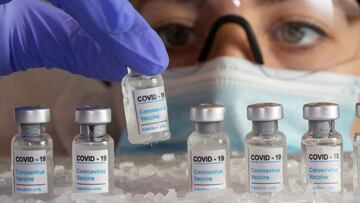Vaccine plans in the US & other countries: when, how many doses and who gets it first?
Each country is making different choices when it comes to the delivery of a coronavirus vaccine. How do the first to the finish line compare?

Authorities all over the world are now all grappling with the same logistical issues of how to distribute the covid-19 vaccine, but each government has taken a slightly different approach. The question of how to store and administer such colossal quantities of one drug are no small feat to overcome; and that’s before you start deciding who gets it first and who has to wait.
Today the UK was the first country to administer a fully authorised covid-19 vaccine. In a historic moment, 90-year-old Margaret Keenan received a shot of the Pfizer/BioNTech vaccine that will be dispensed in the coming weeks.
How do other countries’ strategies compare to the UK and US plans, who is getting the vaccine first, and when?
US vaccine distribution plan
Moncef Slaoui, the head of the US effort to develop a Covid-19 vaccine, praises Joe Biden's plan to ask all Americans to wear masks to curb the spread of the coronavirus https://t.co/EiAocy6fUo
— CNN Breaking News (@cnnbrk) December 6, 2020
On Sunday US health secretary Alex Azar was forced to defend the country’s distribution plan in the face of criticism from president-elect Joe Biden. “There is no detailed plan, that we’ve seen anyway, as to how you get the vaccine out of a container, into an injection syringe, into somebody’s arm,” Biden said.
Azar hit back that the distribution plan was being run by the military and private sector and would use retail pharmacies, public health departments and community health centers, according to the Guardian.
Azar was keen to stress in an interview ABC’s This Week that the initial rollout of a vaccine doesn’t mean that everyday behaviour can go back to normal. “Our advice remains the same in any context, which is wash your hands, watch your distance, wear face coverings when you can’t watch your distance and be careful of those indoor settings,” Azar said.
When and how many doses?
On Thursday 10 December the Food and Drug Administration (FDA) is expected to consider whether to grant the Pfizer/BioNTech vaccine emergency use authorisation. If it does, the first round is expected to be distributed in the following 24 hours.
The US has said that it expects as many as 40 million doses to be available by the end of the year. Reuters reported that Pfizer/BioNTech will be providing 25 million of those and 12.5 million will come from Moderna.
The vaccines both require two doses, meaning that those 40 million doses will vaccinate 20 million Americans. According to MIT Technology Review, those 40,000 will be trickling into the US in shipments ranging from 3 to 10 million doses weekly.
Who gets it first?
The US has arranged the distribution process into phases. The first, 1a, refers to 21 million health-care workers and 3 million adults in long-term care facilities, like nursing homes, who are particularly vulnerable.
Phase 1b will add to that list other essential workers including school staff. Phase 1c adds adults over the age of 65 and those with underlying health issues that increase the risk of complications from the coronavirus.
Following these groups, phase two covers any other people who work in transportation, schools, nursing homes and other places with high concentrations of people, says MIT Technology Review. Phase three encompasses young adults and children – aimed at targeting super spreader events – and then the fourth and final phase constitutes everyone else.
In practice, each state will have significant room for interpretation of the national guidelines, outlined by the CDC’s Advisory Committee on Immunization Practices (ACIP). For instance, each state has a different definition of “essential worker” for instance, affecting how phase one is rolled out state to state.
What’s more, MIT Tech Review reports that analysis of 47 published state plans by the Kaiser Family Foundation found that about half explicitly mentioned race and health equity as a factor.
UK vaccine distribution plan
On Tuesday the UK government reported a further 616 people had died within 28 days of a positive test, taking the total, by that measure, to 62,033. A further 12,282 people tested positive for the virus.
When and how many doses?
The first vaccination, given to Ms. Keenan, was administered in Coventry in the UK at 6:31 this morning local time. UK authorities say that thousands of others followed the first innoculation just today, across around 50 different hospitals.
In the next few weeks the UK will dispense 80,000 doses of the Pfizer / BioNTech vaccine, but up to four million more doses are expected to arrive in the next month.
The UK government has also purchased 100 million doses of the AstraZeneca-Oxford vaccine, 7 million doses of the Moderna vaccine and smaller quantities of other vaccine candidates, bringing the total to 355 million doses, which will more than cover two doses each for 67 million UK citizens.
Who gets it first?
The over 80’s and some health and care staff will be the priority in the UK for the time being. The country’s current distribution plan breaks down the population into nine groups for phase one only, which divides everyone over 50 years old into ascending order of age to correlate with risk. It also includes over 18s with chronic diseases, diabetes, learning difficulties, morbid obesity or severe mental illness being classed as at-risk. Specific plans for later phases have not yet been announced by the Joint Committee on Vaccination and Immunisation (JCVI).
Speaking in the House of Commons, health secretary Matt Hancock stressed that those eligible for the vaccine would be contacted by the National Health Service (NHS) in due course and urged individuals the “please step forward for your country.”
China vaccine distribution plan
According to John Hopkins University, as of 3 December 2020 China had officially reported 93,203 cases and 4,744 covid-19 deaths. That’s far fewer cases and deaths than in the United States, which has recorded more than 14 million cases and more than 275,250 deaths.
When and how many doses?
According to the South China Morning Post, Chinese scientists have predicted that 600 million doses of the covid-19 vaccine will be ready in the country by the end of this year.
Two companies called Sinopharm and Sinovac Biotech are the front-runners among four major manufacturers who are all in phase three clinical trials in China and 15 other countries. None have been approved for commercial use so far, though emergency authorisation was already granted this year to both leading candidates and vaccinations have already begun. In China emergency use authorisation can be granted to unapproved vaccine candidates if for use in people at high risk of being infected.
Who gets it first?
Related stories
Approximately 1 million people have already been vaccinated under the emergency use authorisation granted in China earlier this year. In June an unknown number of People’s Liberation Army members were vaccinated, then in July essential city workers, employees of state-owned enterprises, Huawei employees in 180 countries, and Chinese diplomats were vaccinated too.
Russia vaccine distribution plan
Russia was the first country in the world to approve a vaccine on 11 August 2020, before the Sputnik V has even begun phase three trials. As trials continue, the country is gearing up for mass immunisations. President Vladimir Putin has promised that the vaccine will be free of charge and won’t be obligatory.
